báo cáo khoa học: "Unusual histological findings after partial pancreaticoduodenectomy including benign multicystic mesothelioma, adenomyoma of the ampulla of Vater, and undifferentiated carcinoma, sarcomatoid variant: a case series" pdf
Bạn đang xem bản rút gọn của tài liệu. Xem và tải ngay bản đầy đủ của tài liệu tại đây (521.33 KB, 5 trang )
CAS E REP O R T Open Access
Unusual histological findings after partial
pancreaticoduodenectomy including benign
multicystic mesothelioma, adenomyoma of the
ampulla of Vater, and undifferentiated carcinoma,
sarcomatoid variant: a case series
Nadja Lehwald
1
, Kenko Cupisti
1*
, Stephan E Baldus
2
, Patric Kröpil
3
, Jan Schulte am Esch II
1
, Claus F Eisenberger
1
,
Wolfram T Knoefel
1
Abstract
Introduction: The standard operation for carcin oma of the pancreatic head is a partial pancreaticoduodenectomy.
Unusual histological findings may occasionally occur in the surgical specimen. We present three unusual histologic
diagnoses after pancreaticoduodenectomy.
Case presentations: In the first case, an 86-year-old Caucasian woman was admitted with abdominal pain and
nausea. Preoperative evaluation showed a 3 cm cystic les ion in the head of the pancreas. Pathology revealed a
benign multicystic mesothelioma. In the second case, a 45-year-old Caucasian man complained of nausea,
vomiting and general mala ise for several months. Endoscopic retrograde cholangiopancreatographic examination
and a computed tomography scan showed a stenosis of the distal bile duct secondary to a mass in the head of
the pancreas and duodenum. Histology showed an adenomyoma of the ampulla. In the third case, a 59-year-old
Caucasian man presented with chronic alcoholic pancreatitis. A computed tomography scan revealed a 3.5 cm
lesion in the head of the pancreas with cystic and solid components. Pathology showed an undifferentiated
carcinoma, sarcomatoid variant.
Conclusion: Partial pancreaticoduodenectomy is usually performed for ductal adenocarcinomas, neuroendocrine
tumors or chronic pancreatitis. Compared to the majority of the above diagnoses, the three cases in our study are
very rare. Benign multicystic mesothelio ma is a very rare tumor that originates from the peritoneum. Although it
demonstrates a benign clinical behaviour, it frequently recurs after resection. Adenomyoma of the bile duct or
ampullary region is a very unusual, benign, localized lesion characterized by adenomyomatous hyperplasia.
Undifferentiated carcinoma, sarcomatoid variant, is an aggressive tumor and is characterized by spindle cells. As the
lesions were suspicious for carcinoma, partial pancreaticoduodenectomy was justified in all three patients. The
histologic diagnosis after partial pancreaticoduodenectomy may differ from the preoperative and intraoperative
findings. These cases demonstrate that a definitive diagnosis may only be obtained by a pathologic examination of
the surgical specimen.
* Correspondence: e
1
Department of General, Visceral and Pediatric Surgery; Heinrich-Heine-
University Duesseldorf, Moorenstr. 5, 40225 Duesseldorf, Germany
Full list of author information is available at the end of the article
Lehwald et al. Journal of Medical Case Reports 2010, 4:402
/>JOURNAL OF MEDICAL
CASE REPORTS
© 2010 Lehwald et al; licensee BioMed Central Ltd. This is an Open Access article distributed under the terms of the Creative
Commons Attribution License (http://cre ativecommons.org/licenses/by/2.0), which permits unrestricted use, distribution, and
reproduction in any medium, provided the original work is properly cited.
Introduction
The standard o peration for pancreatic cancer within the
head of the pancreas or uncinate process is a partial pan-
creaticoduodenectomy (’Whipple procedure’). The stan-
dard Whipple procedure involves the removal of the head
of the pancreas, the distal part of the stomach, the duode-
num, the first part of the jejunum, the common bile duct
and the gallbladder. Pancreaticoduodenectomy was popu-
larized by Dr Allen Whipple after his success in his initial
three cases in 1935 [1]. The technique has undergone sev-
eral technical modifications and revisions, so that morbid-
ity and mortality rates have dramatically decreased o ver
the past several decades [2]. In 1978, Traverso and Long-
mire described the pylorus-preserving pancreaticodu ode-
nectomy (PPPD), a procedure already mentioned by
Watson in 1944 [3]. The expected advantages of this pro-
cedure were less dumping, improved gastrointestinal func-
tion and reduced jejunal ulceration.
Occasionally, unusual pathology was present in the
surgical specimens w hich were not initially suspected.
We present three unusual histological findings.
Case presentations
Case 1
An 86-year-old Caucasian woman was admitted with
nausea and abdominal pain. Abdominal and endoscopic
ultrasound, as well as a computed tomography (CT)
scan, showed a 3 cm cystic lesion in the head of the
pancreas with a dilated pancreatic duct and regional
lymphadenopathy (Figure 1). Ultrasound-guided fine
needle aspiration showed no malignant cells. Preopera-
tive CA19-9 level was 54.1 U/mL (reference value < 27
U/mL). Nevertheless, based upon the morphological and
radiological findings, a malignant cystic pancreatic
tumor (for example, cystadenocarcinoma) was suspected.
Intraoperatively, a firm, cystic lesion was found in the
head of the pancreas with suspicious infiltration of the
superior mesenteric vein (SMV). We were unable to
exclude malignancy on frozen section, so we performed
a modification on Whipple procedure with a partial
resection and end-to-end anastomosis of the SMV. The
postoperative course was uneventful. Ten months later,
the patient had no signs of recurrence.
A gross 2.5 cm tumor of the head of the pancreas was
described. Histopathology showed multiple small cysts
covered by cubic mesothelial cells with uniform, small
nuclei ( Figure 2A and 2B). Immuno histochemistry
revealed a strong immunoreactivity for cytokeratin,
vimentin and CK5. CD31 and CD34 immunoreactivity
was not expressed by the cystic epithelium. There was
no invasive growth or malignancy. Based on the histo-
pathological and immunohistochemical findings, the
final diagnosis was benign multicystic mesothelioma.
Case 2
A 45-year-old Caucasian man complained of nausea,
vomiting and general malaise for several months. CA19-9
was within normal range (20.5 U /mL). A CT scan of the
abdomen and endoscopic retrograde cholangiopancreato-
graphic (ERCP) examination showed a mass in the head of
the pancreas and duodenum with a stenosis of the duode-
num and distal bile duct (Figure 3). Due to the duodenal
stenosis and the recent onset of chronic pancreatitis we
performed a duodenum-preserving head of the pancreas
resection. There was severe chronic inflammation of the
head of the pancreas and body intraoperatively. There was
no evidence of peritoneal dissemination or hepatic metas-
tases. An intraoperative frozen section showed atypical
cells in the resection margin which could not be clearly
identified as benign. Thus, the operation was extended to
a pancreaticoduodenectomy . The patient recovered and
was discharged on postoperative day (POD) 13.
Figure 1 Benign multicystic mesothelioma of the head of the
pancreas: computed tomography scan of the abdomen shows
a multicystic lesion of the head of the pancreas with dilated
pancreatic duct and regional lymphadenopathy.
Figure 2 Histologic findings of benign multicystic
mesothelioma of the pancreas. (A) The tumor is composed of
thin-walled, multilocular cysts (100×). (B) The wall of the cyst, lined
with single layer of cuboidal epithelium and separated by thin
collagenous septae (200×).
Lehwald et al. Journal of Medical Case Reports 2010, 4:402
/>Page 2 of 5
A macroscopic examination rev ealed a 5.5 cm lesion
in the ampulla of Vater. Microscopically, multiple hyper-
plastic glands and cysts were found. They were covered
by a single-layer epithelium, consisting of cuboidal,
columnar and, in part, mucinous cells. Hyperplastic
glandular lobes were surrounded by hyperplastic
mesenchymal tissue which consisted of muscle fibers,
fibroblasts and m yofibroblasts (Figure 4A and 4B).
There was no invasive component. The lesion was
described as an adenomyoma of the ampulla.
Case 3
A 59-year-old Caucasia n man presented with chronic
alcoholic p ancreatitis. An ultrasound and a CT scan of
the abdomen showed a 3.5 cm l esion of the head of the
pancreas with cystic and solid parts (Figure 5). The
tumor marker CA19-9 was strongly elevated (74.3 U/
mL). Due to our suspicion of pancreatic carcinoma on a
background of chronic pancreatitis, we performed a par-
tial pancreaticoduodenectomy with radical lymphade-
nectomy. The postoperative course was uneventful and
the patient was discharge d on POD 13. The patient was
given chemotherapy with gemcitabine according to the
protocol for adenocarcinoma following surgery. On a
follow-up CT scan eight months after surgery two new
liver metastases were discovered. As the patient was in
good health, we resected the two liver metastases by the
left hemihepatectomy. The patient tolerated the second
operation well.
Macroscopically, a 3.7 cm cystic malignant tumor of
the head of the pancreas was found. Microscopically,
the malignant tumor contained undifferentiated spindle
cells (Figure 6A and 6B). All lymph nodes and resection
margins were tumor free. Immunohistochemistry stains
were strongly positive for vimentin. Some cells
expressed cytokeratin, CK5, desmin and myogenine (Fig-
ure 6C). The proliferation index was 30%-40%. Tumor
cells were negative for CD34, c-kit, sm-actin and S100.
Figure 3 Adenomyoma of the pancreas: abdominal computed
tomography scan reveals severe duodenitis (↦), a stent in the
common hepatic duct (*) and a dilated duct of Wirsung (**).
Figure 4 Histologic findings and immunohistochemical staining
for smooth muscle actin in adenomyoma. (A) Several glands
lined by bland looking, single layer of cuboidal to columnar
epithelium are surrounded by hyperplastic mesenchymal tissue
(100×). (B) Proliferating smooth muscle cells show immunoreactivity
for smooth muscle actin.
Figure 5 Undifferentiated carcinoma, sarcomatoid variant of
the head of the pancreas: computed tomography scan of the
abdomen shows a lesion of the head of the pancreas head
with cystic and solid parts.
Lehwald et al. Journal of Medical Case Reports 2010, 4:402
/>Page 3 of 5
In co nclusion, the diagnosis of an undifferentiated carci-
noma, sarcomatoid variant was established. The Union
for International Cancer Control classification was pT2,
pN0 (0/12), pM0, G4 and R0.
Discussion
The most common indications for pancreatic resection
are ductal adenocarcinoma, a neuroendocrine tumor or
chronic pancreatitis. The three cases we have descri bed
are rare. We would like to present an overview of these
unusual conditions:
Benign multicystic mesothelioma was first described
by Mennemeyer and Smith in 1979 [4]. It is a very rare
tumor originating from the peritoneum but it can also
be found on serosal surfaces (for example, intestine,
liver and kidney). To our knowledge, this is the first
description in t he literature of benign multicystic
mesothelioma of the pancreas.
Although it is a tumor with a benign clinical beha-
viour, it frequently recurs after surgical resection. A
report of 15 cases revealed a recurrence rate of 26.7%
[5,6]. Time between recurrences may range from four
months t o 12 years [7]. As it has a tendency to recur, a
neoplastic etiology is supported. In our patient, 10
months postoperatively there had been no evidence of
recurrence.
Benign multicystic mesothelioma is found mainly in
women of reproductive age with a past history of
abdominal surgery or endometriosis [8]. Only a few
reports exist of this gynecologic diagnosis in elderly
women [9]. Our patient had not undergone any previous
abdominal surgery.
The clinical findings o f benign multicystic mesothelio-
mas are non-specific and include nausea, vomiting and
abdominal pain. There is often a palpable abdominal
mass, although this was not present in our case [10].
Preoperative diagnosis is often difficult and several dif-
ferential diagnoses must be considered. As this tumor
has a high risk of recurrence, a close follow-up should
be performed in every patient.
Adenomyomas are common in the stomach, gallblad-
der and jejunum but are very unusual in the common
bile duct or the ampullary region [11]. Adenomyomas of
the extrahepatic bile duct are defined as non-neoplastic,
tumor-like localized lesions c haracterized by glan dular
and myomatous hyperplasia without cellular atypia [12].
In the absence of gallstones, extrahepatic bile duct ade-
nomyomas often stay dormant for long periods and may
eventually cause vague symptoms due to local pressure
[13]. They also cause obstructive jaundice, as in this
case, w hich can easily be misinterpreted as a malignant
neoplasm. It is difficult to differentiate between biliary
adenomyomas and other malignant lesions by radiology
(CT). Since malignancy is often suspected preopera-
tively, surgery with the intent to cure should be
performed.
The etiology of adeno myom as of the extrahepatic bile
duct and the ampulla of Vater is unkno wn. As different
terms are used in the literature to describe the same his-
tological lesion, the true incidence of adenomyomas of
the ampullary region is unclear. In the literature, 30
cases of adenomy omas of the ampulla of Vater and 13
cases of the extrahepatic bile duct have been reported
[11,13]. Adenomyomas are usually diagnosed by histo-
pathologic examination after surgery. As in our case, it
often turns out to be a surprising diagnosis.
Undifferentiated carcinoma, sarcomatoid variant, is a
rare variant of pancreatic tumors. The malignant tumor
arises de novo or occurs in association with mucinous
cysts or other pancreatic neoplasms. Men are affected
more often than women with a ratio of 3:1 and a mean
age at diagnosis of 63 years. The most common symp-
toms are fatigue, nausea and vomiting, weight loss and
abdominal pain. As in our case, radiologic imagi ng often
shows an aggressive pancreatic mass which is not speci-
fic for undifferentiated carcinoma. Undifferentiated car-
cinomas are usually very large, aggressive neoplasms
(average size 9-10 cm size). The prognosis is often lim-
ited to several months after resection [14]. Our patient
remains in good physical condition seven months post-
operatively, although he did develop two new liver
metastases under chemotherapy which were resected. In
contrast to our case, metastases are usually present at
the time of diagnosis, the most common sites being
lymph nodes, liver and lung. Surgical resection is the
treatment o f choice, although most of these neoplasms
Figure 6 Histologic findings and immunohistochemical staining
for cytokeratin in undifferentiated carcinoma, sarcomatoid
variant. (A) The tumor is highly cellular and arranged in short
fascicles and whorls (200×). (B) Tumor cells have oval to spindle
shaped hyperchromatic nuclei (400×). (C) Scattered tumor cells are
positive for cytokeratin immunostaining (400×).
Lehwald et al. Journal of Medical Case Reports 2010, 4:402
/>Page 4 of 5
have already metastasized in the majority of patients by
the time of diagnosis [15]. Histologically, the neoplasm
mayresembleasarcomaduetothespindlecells.In
contrast to a carcinomasarcoma, which consists of a
mixture of glandular and spindle cell differentiation, an
undifferentiated carcinoma, sarcomatoid variant, has
only a prominent spindle cell differentiation. Cytokeratin
is expressed in over 80%. Sarcomatoid carcinomas can
be differentiated from carcinosarcomas which immuno-
histochemically show cytokeratin and vimentin reactivity
and are, therefore, not considered to be true carcinomas
[16]. The spindle cells of sarcomatoid carcinomas often
label for actin, although desmin is not frequently
expressed. In our case desmin was expressed and actin
was negative.
Conclusion
In light of these factors, complete resection offers the
only potentially curative treatment option in malignant
tumors of the head of the pancreas. A preoperative diag-
nosis could not be obtained in any of our cases without
a biopsy. Although adenocarcinoma of the pancreas was
suspected preoperatively in each case, the final pathol-
ogy demonstrated unexpect ed and unusual diagnoses.
Due to the suspicion of a carcinoma, partial pancreati-
coduodenectomy was justified in all three patients.
Although the Whipple procedure is still considered to
be a major surgical intervention with high morbidity
and low lon g-term survival, partial pancreaticoduode-
nectomy is indicated for all suspicious tumor-like lesions
of the head of the pancreas. These unexpected patholo-
gic diagno ses underscore the fact that confirmatory evi-
dence of suspicious diagnoses by surgery is still the gold
standard.
Consent
Written informed consent was obtained from all
patients for publication of this case report and accompa-
nying images. A copy of the written consents is available
for review by the Editor-in-Chief of this journal.
Abbreviations
CT: Computed Tomography; ERCP: Endoscopic Retrograde
Cholangiopancreatography; CK: cytokerati n; CD: Cluster of differentiation;
CA19-9: carbohydrate antigen 19-9; POD: postoperative day; PPPD: pylorus-
preserving pancreaticoduodenectomy.
Author details
1
Department of General, Visceral and Pediatric Surgery; Heinrich-Heine-
University Duesseldorf, Moorenstr. 5, 40225 Duesseldorf, Germany.
2
Department of Pathology; Heinrich-Heine-University Duesseldorf, Moorenstr.
5, 40225 Duesseldorf, Germany.
3
Department of Radiology; Heinrich-Heine-
University Duesseldorf, Moorenstr. 5, 40225 Duesseldorf, Germany.
Authors’ contributions
NL was involved in the conception and design and wrote the first draft of
the manuscript. KC was involved in the preparation and review of the
manuscript, the literature review and made a substantial intellectual
contribution. SEB performed the histopathological work-up and contributed
to the pathology part of the manuscript. PK performed the radiological
work-up and contributed to the radiology part of the manuscript. JSaE and
CFE performed surgery and critically revised the manuscript. WTK was
involved in the initiation of the report and made a substantial intellectual
contribution to the conception, acquisition and interpretation of the data.
All authors read and approved the final manuscript.
Competing interests
The authors declare that they have no competing interests.
Received: 3 December 2009 Accepted: 10 December 2010
Published: 10 December 2010
References
1. Whipple AO, Parsons WB, Mullins CR: Treatment of carcinoma of ampulla
of Vater. Ann Surg 1935, 102:763-779.
2. Trede M, Schwall G, Saeger H: Survival after pancreaticoduodenectomy:
118 consecutive resections without an operative mortality. Ann Surg
1990, 211:447-458.
3. Traverso LW, Longmire WP: Preservation of the pylorus in
pancreaticoduodenectomy. Surg Gynecol Obstet 1978, 146:959-962.
4. Mennemeyer R, Smith M: Multicystic, peritoneal mesothelioma: a report
with electron microscopy of a case mimicking intraabdominal cystic
hygroma (lymphangioma). Cancer 1979, 44:692-698.
5. Sawh RN, Malpica A, Deavers MT: Benign cystic mesothelioma of the
peritoneum: a clinicopathologic study of 17 cases and
immunohistochemical analysis of estrogen and progesterone receptor
status. Hum Pathol 2003, 34:369-374.
6. Katsube Y, Mukai K, Silverberg SG: Cystic mesothelioma of the
peritoneum. A report of five cases and review of the literature. Cancer
1982, 50:1615-1622.
7. Schnieder V, Partridge JR, Demay RM: Benign cystic mesothelioma
involving the female genital tract: report of four cases. Am J Obstet
Gynecol 1983, 145:355-359.
8. Ross MW, Welch WR, Scully RE: Multilocular peritoneal inclusion cysts (so-
called cystic mesotheliomas). Cancer 1989, 64:1336-1346.
9. De Toma G, Nicolanti V, Plocco M: Cystic peritoneal mesothelioma: report
of a case. Surg Today 2000, 30:98-100.
10. Häfner M, Novacek G, Gangl A: Giant benign cystic mesothelioma: a case
report and review of the literature. European J Gastroenterology
Hepatology 2002, 14:77-80.
11. Iwaki K, Shibata K, Kitano S: Adenomyomatous hyperplasia of the
common bile duct: report of a case. Surg Today 2008, 38:85-89.
12. Imahi S, Uchiyama S, Kodama H: Adenomyoma of the common hepatic
duct. J Gastroenterol 1995, 30:547-550.
13. Handra-Luca A, Terris B, Flejou JF: Adenomyoma and adenomyomatous
hyperplasia of the Vaterian system: clinical, pathological and new
immunohisctochemical features of 13 cases. Mod Pathol 2003, 16:530-536.
14. Barkatullah SA, Deziel DJ, Komanduri S: Pancreatic carcinosarcoma with
unique triphasic histological pattern. Pancreas 2005, 31
:291-292.
15. Sodergren MH, Silva MA, Read-Jones SL: Carcinosarcoma of the biliary
tract: two case reports and a review of the literature. Eur J Gatroenterol
Hepatol 2005, 17:683-685.
16. Gelos M, Behringer D, Philippou S: Pancreatic carcinosarcoma. Case report
of multimodal therapy and review of the literature. J Pancreas (online)
2008, 9:50-55.
doi:10.1186/1752-1947-4-402
Cite this article as: Lehwald et al.: Unusual histological findings after
partial pancreaticoduodenectomy including benign multicystic
mesothelioma, adenomyoma of the ampulla of Vater, and
undifferentiated carcinoma, sarcomatoid variant: a case series. Journal of
Medical Case Reports 2010 4:402.
Lehwald et al. Journal of Medical Case Reports 2010, 4:402
/>Page 5 of 5
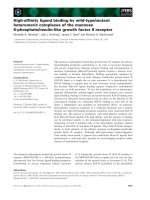
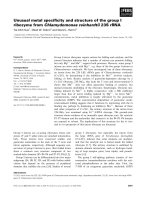
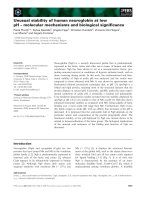

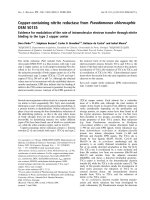

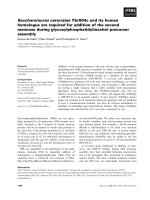
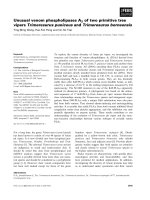
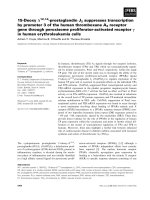
![Báo cáo khoa học: [Na+]i-induced c-Fos expression is not mediated by activation of the 5¢-promoter containing known transcriptional elements ppt](https://media.store123doc.com/images/document/14/rc/kt/medium_AqRuqpZDo1.jpg)